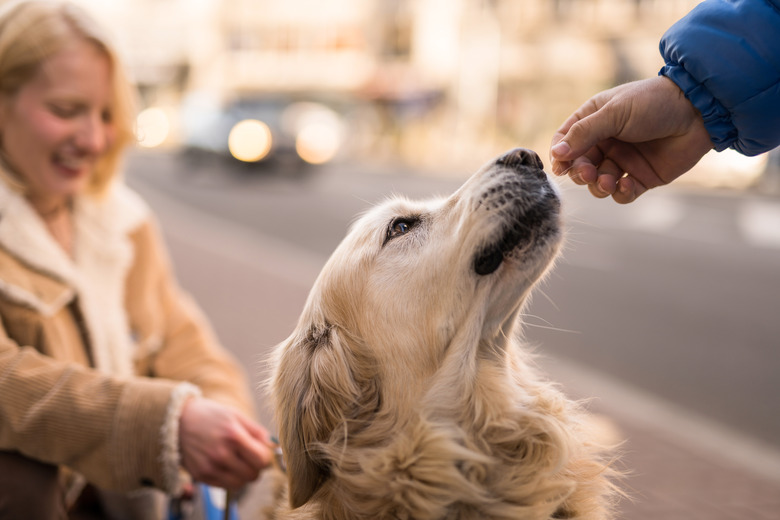Canine Symptoms Of Excessive Food & Water Consumption
Excessive food and water consumption can cause problems on their own, but if your dog has increased appetite and thirst together, it could be a sign of a medical condition, such as diabetes or Cushing's disease. Other symptoms may include increased urination and a distended abdomen. If your dog has increased appetite and thirst, be sure to take him to see a veterinarian to determine the cause and get the appropriate treatment.
Polyphagia in dogs
Polyphagia in dogs
Hyperphagia or polyphagia in dogs refers to excessive food consumption. There may be a physiological cause for overeating, such as stress or pregnancy, or polyphagia may be a symptom of another condition, such as diabetes or hyperthyroidism. If your pup suddenly has an increased appetite, consult your veterinarian to screen for any underlying conditions.
If your dog is experiencing polyphagia and he has free access to food, whether he is free fed or steals food from your table, he may suffer food bloat from overfilling his stomach. Symptoms may include drooling, retching, panting, a swollen abdomen, and lethargy. Dogs may also have increased or decreased thirst.
While food bloat is not generally life threatening, you should still consult your veterinarian. Depending on what and how much your dog ate, your vet may need to induce vomiting or give your dog fluids to keep him hydrated.
Excessive water consumption in dogs
Excessive water consumption in dogs
Increased thirst can be perfectly normal if you are starting a new exercise routine with your pup or when the temperatures rise in the summer. However, it can also be a symptom of a more serious medical condition, such as diabetes. In most cases, increased water consumption on its own does not cause serious complications, as with increased water consumption comes increased urination.
However, if your dog really overdoes it, whether because this is a symptom of an underlying illness or because she is drinking while playing in the water, she may suffer water intoxication. When your dog drinks too much water, the sodium in the bloodstream gets diluted and causes the cells in the body to take in more water. This causes swelling in the brain and can result in serious complications including seizures, coma, and death. Earlier symptoms may include bloating, drooling, vomiting, pale gums, dilated pupils, and lethargy.
This is a serious condition that requires veterinary attention. Your vet will slowly introduce electrolytes to rebalance your pup's system. He may also administer a diuretic to help your dog rid her body of excess water and prescribe other medications to help control swelling in the brain.
Cushing's disease in dogs
Cushing's disease in dogs
A dog with increased hunger and thirst is showing the primary signs of Cushing's disease. Other symptoms include increased urination, lethargy, and poor coat condition. As the disease progresses, your dog may develop a pot belly, frequent bladder infections, thin skin, and dark-colored spots on the skin.
Cushing's disease occurs when the adrenal glands are overactive and produce too much of certain hormones. The condition may be caused by a tumor on the pituitary or adrenal gland or as the result of taking steroid medication over a long period of time.
If the disease is caused by steroid medications, your dog can be weaned off them. If it is caused by a tumor, treatment depends on the size and location of the tumor. Your veterinarian may recommend surgery to remove an adrenal tumor if possible. There are also several medications your vet may prescribe to manage the condition.
Diabetes in dogs
Diabetes in dogs
If your senior dog has increased appetite and thirst, he may have diabetes. Most dogs are diagnosed when they are 7 to 9 years old, but they can be diagnosed when they are much younger or older. Other symptoms of diabetes include increased urination, bladder infections, weight loss, and cataracts.
Dogs with diabetes don't produce enough insulin to process the sugar in the bloodstream after a meal. While the disease can't be cured, it is treatable. Your veterinarian will help wean your dog off any medications contributing to insulin resistance if possible. You will need to maintain a regular routine, including exercising and feeding your dog at consistent times and administering insulin injections as prescribed by your vet.
References
- Veterian Key: Polyphagia and Hyperphagia
- Preventive Vet: Food Bloat in Dogs: Did Your Dog Eat Too Much?
- VCA Animal Hospitals: Cushing's Disease in Dogs
- Sydney Veterinary Emergency & Specialists: Diabetes Mellitus in Dogs
- American Kennel Club: Can Dogs Drink Too Much Water? The Dangers of Water Intoxication
